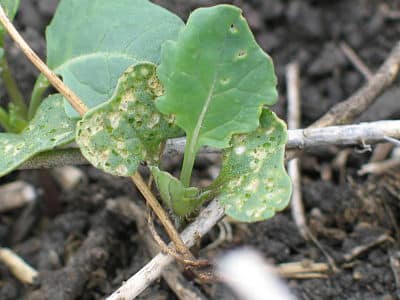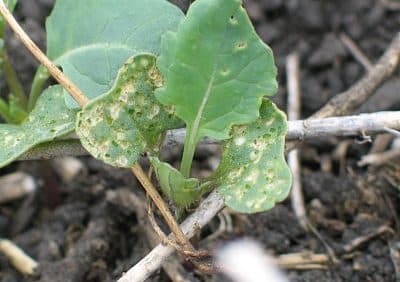Take a few extra minutes each day to scout emerged crop for insect damage. Rain delays provide time to give each field a close inspection.
Flea beetles
High levels of flea beetles have been observed in the Peace River region, but right now they’re feeding on volunteer canola because not a lot of crop has emerged. For crop that is emerged, scout and assess the threat before spraying.
 When 25% of leaf area is lost, on average, and flea beetles are still present and feeding, then a foliar spray will often pay off. But look closely at the damage, including on the underside of cotyledons and stems. If damage on first leaves is less than on cotyledons, this may indicate flea beetle pressure is waning. A spray may not be warranted in that case, but keep scouting — especially if this is an early crop and the overall flea beetle threat continues. With higher temperatures, flea beetle pressure can change in a hurry. Keep scouting until the threat is known to be over.
When 25% of leaf area is lost, on average, and flea beetles are still present and feeding, then a foliar spray will often pay off. But look closely at the damage, including on the underside of cotyledons and stems. If damage on first leaves is less than on cotyledons, this may indicate flea beetle pressure is waning. A spray may not be warranted in that case, but keep scouting — especially if this is an early crop and the overall flea beetle threat continues. With higher temperatures, flea beetle pressure can change in a hurry. Keep scouting until the threat is known to be over.
Spot or perimeter spraying may be enough in some cases, if populations are moderate and cool conditions keep them less mobile. Flea beetles overwinter in forage areas, shelterbelts and grass areas along field borders. Start looking for damage in parts of the field that border these areas. Spot spraying may be all that’s required.
Cutworms
In a canola field near Vermilion, Alta., 3 out of 10 plants per row were found clipped off this week. Digging uncovered 2 to 3 pale western cutworms per foot of row. Over on a field near Westlock, Alta., dingy cutworms were found feeding at 2:00 in the afternoon, which is uncharacteristic of cutworms. Cutworms are usually nocturnal. Cutworms will be a pest to watch again this year. Click here for more on cutworm identification, scouting, thresholds and control measures.
Wireworms
Wireworms are another below-ground feeder, like some cutworms, and can cause bare patches or wilting plants to appear in canola fields. (Note that there are other potential causes for these symptoms, including wet conditions.) Wireworm numbers tend to be higher in pasture or hayland put into annual crop production. Nothing is registered or effective for wireworm control in canola. If wireworms are found, this gives us an opportunity to identify what species are present in an area and find out more about the insects. It also helps to develop control strategies for the future. You can send samples to Bob Vernon at Agriculture and Agri-Food Canada’s Pacific Agri-Food Research Centre. The address is 6947 Highway 7, PO Box 1000, Agassiz, B. C. V0M 1A0.

